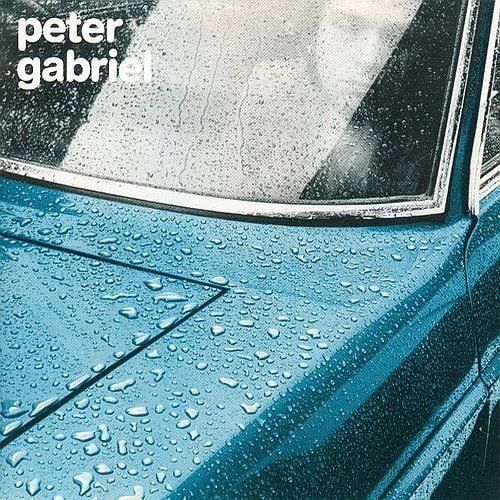Peter Gabriel’s debut solo album, commonly referred to as ‘Car,’ marks a significant departure from his work with the legendary progressive rock band Genesis. Released in 1977, ‘Car’ emerges as a bold statement of individual artistic identity, exploring themes and sounds that Gabriel would continue to develop throughout his solo career. Following his departure from Genesis in 1975, Gabriel sought to establish himself as a solo artist with a distinctive voice, both musically and thematically. This album is not merely a continuation of his previous work but rather an evolution that delves into uncharted territories of art rock and progressive pop.
In the broader music landscape of the late 1970s, ‘Car’ stands out amidst a sea of punk rock and disco, offering a complex and introspective alternative. At a time when the music industry was experiencing seismic shifts, Gabriel’s album provided a fresh perspective, blending intricate musical arrangements with poignant lyricism. This artistic vision is evident in the album’s meticulous production, helmed by the legendary Bob Ezrin, known for his work with Alice Cooper and Pink Floyd. Together, Gabriel and Ezrin crafted an album that is as much a sonic experiment as it is a collection of songs.
Artistic Intentions
Gabriel’s intentions with ‘Car’ were multifaceted. He aimed to break free from the confines of the prog-rock genre, showcasing his versatility and willingness to embrace diverse influences. In interviews and album notes, Gabriel has emphasized his desire to create music that is both accessible and thought-provoking, combining the personal with the universal. This is reflected in tracks like “Solsbury Hill,” which narrates his departure from Genesis and his journey towards self-discovery, and “Here Comes the Flood,” which addresses broader existential themes.
Sonic Exploration

The production quality of Peter Gabriel’s ‘Car’ is nothing short of exceptional. Bob Ezrin’s involvement as the producer brought a polished and cinematic dimension to the album, characterized by its crisp and clear sound. Ezrin, renowned for his work with theatrical rock acts, employed a meticulous approach to the production, ensuring that each track was a meticulously crafted soundscape. This high production value serves to enhance the album’s introspective and often haunting themes, providing a lush backdrop that allows Gabriel’s storytelling to shine.
Musical Arrangements
Musically, ‘Car’ is a testament to Gabriel’s innovative spirit. The arrangements are intricate and multi-layered, blending traditional rock instrumentation with more unconventional elements. The opening track, “Moribund the Burgermeister,” sets the tone with its eclectic mix of synthesizers, guitar riffs, and dynamic percussion, creating a sense of theatrical urgency. Gabriel’s distinctive voice is at the forefront, seamlessly transitioning from gentle whispers to powerful, soaring vocals.
“Solsbury Hill,” perhaps the most iconic track on the album, features an unforgettable acoustic guitar riff that drives the song’s rhythm, complemented by subtle layers of synthesizers and a buoyant bassline. The arrangement is both simple and profound, perfectly capturing the song’s themes of liberation and self-realization. In “Here Comes the Flood,” the orchestral arrangement builds to a dramatic crescendo, underscoring the apocalyptic narrative and highlighting Gabriel’s emotional delivery.
Genre Elements
‘Car’ traverses a broad musical landscape, touching upon art rock, progressive rock, and pop, while also incorporating elements of folk and world music. This genre-blending is particularly evident in tracks like “Excuse Me,” which features a barbershop quartet, and “Down the Dolce Vita,” which combines rock with orchestral flourishes. Gabriel’s willingness to experiment with different styles and sounds results in an album that feels both cohesive and exploratory.
Lyrical Analysis

Peter Gabriel’s ‘Car’ is rich with lyrical depth, weaving together a tapestry of themes and messages that are both personal and universal. Central to the album is the theme of self-discovery and transformation, a reflection of Gabriel’s own journey as he transitioned from being the frontman of Genesis to a solo artist. This theme is most poignantly expressed in “Solsbury Hill,” where Gabriel narrates his departure from Genesis and the sense of liberation and self-awareness that followed. The line, “My heart going boom boom boom, ‘Son,’ he said, ‘Grab your things, I’ve come to take you home,’” encapsulates the exhilaration and apprehension of embarking on a new path.
Another recurring motif is the exploration of human consciousness and existential concerns. In “Here Comes the Flood,” Gabriel delves into themes of apocalypse and renewal, painting vivid images of a world facing a cataclysmic event. The lyrics, “Lord, here comes the flood / We’ll say goodbye to flesh and blood,” convey a sense of inevitability and rebirth, urging listeners to contemplate the fragility and resilience of the human spirit.
Lyrical Depth
Gabriel’s lyrics on ‘Car’ are a blend of straightforward narrative and abstract poetry, offering multiple layers of interpretation. Songs like “Moribund the Burgermeister” and “Modern Love” employ surreal and sometimes cryptic imagery, challenging listeners to delve deeper into their meanings. In “Moribund the Burgermeister,” the bizarre and theatrical lyrics depict a character grappling with paranoia and societal control, while “Modern Love” critiques the superficiality and disconnection in contemporary relationships.
The poetic nature of Gabriel’s writing is evident throughout the album. His use of metaphor and symbolism adds a layer of complexity, inviting listeners to uncover hidden meanings. In “Slowburn,” the lyrics “We’re living in a slow burn, no fire, no ember / Just a room to discover” evoke a sense of lingering tension and the slow realization of inner truths. Gabriel’s ability to intertwine personal introspection with broader societal commentary gives the album a timeless quality.
Emotional Impact
The emotional impact of ‘Car’ is profound, with Gabriel’s lyrics evoking a wide range of feelings. The sense of liberation and hope in “Solsbury Hill” contrasts with the melancholic reflection in “Here Comes the Flood.” Tracks like “Humdrum” and “Waiting for the Big One” capture a sense of ennui and anticipation, resonating with listeners on a deeply emotional level. Gabriel’s evocative storytelling and emotive delivery ensure that each song leaves a lasting impression, whether it’s the joy of newfound freedom, the sadness of impending loss, or the contemplation of existential themes.
Cohesion and Flow

‘Car’ is a masterclass in cohesion and flow, with Peter Gabriel carefully curating a track progression that feels both deliberate and seamless. The album’s structure takes listeners on a journey, each song flowing into the next with a sense of narrative and emotional continuity. This progression not only highlights Gabriel’s versatility as an artist but also maintains a compelling arc that ties the entire album together.
Track progression
The opening track, “Moribund the Burgermeister,” sets a dramatic and somewhat unsettling tone with its eclectic mix of sounds and surreal lyrics. This track serves as an intriguing introduction, drawing listeners into Gabriel’s unique world. The transition to “Solsbury Hill” is smooth, shifting from the theatrical intensity of the opener to the uplifting and introspective mood of this iconic song. The juxtaposition between these tracks exemplifies Gabriel’s ability to balance contrasting emotions while maintaining a cohesive flow.
As the album progresses, tracks like “Modern Love” and “Excuse Me” introduce different styles and themes without disrupting the overall coherence. “Modern Love” continues the exploration of personal and societal themes with a rock-driven energy, while “Excuse Me” offers a whimsical diversion with its barbershop quartet arrangement. Despite their stylistic differences, both songs contribute to the album’s overarching narrative of self-exploration and transformation.
“Humdrum” and “Slowburn” serve as a reflective midpoint, delving deeper into themes of ennui and inner turmoil. These tracks are thoughtfully placed, allowing listeners to pause and reflect before the more intense and dramatic compositions that follow. The transition from the introspective “Humdrum” to the urgent and explosive “Slowburn” is particularly effective, demonstrating Gabriel’s skill in crafting an emotionally engaging listening experience.
The latter part of the album, including “Waiting for the Big One” and “Down the Dolce Vita,” builds towards a climactic conclusion. “Waiting for the Big One” is a bluesy, contemplative track that adds depth to the album’s emotional landscape, while “Down the Dolce Vita” ramps up the intensity with its orchestral grandeur. This progression culminates in the final track, “Here Comes the Flood,” which ties together the album’s themes of apocalypse and renewal with a powerful, cathartic ending.
Thematic Consistency
Thematic consistency is one of ‘Car’s’ greatest strengths. Throughout the album, Gabriel maintains a focus on introspection, transformation, and the human condition, exploring these themes through a variety of musical styles and lyrical narratives. While the album traverses different genres and moods, it never feels disjointed. Instead, each track contributes to a cohesive whole, unified by Gabriel’s distinctive voice and artistic vision.
Standout Tracks and Moments
Peter Gabriel’s ‘Car’ is an album replete with standout tracks and memorable moments that showcase his artistic prowess and innovative spirit. While the album as a whole is a cohesive and compelling work, several tracks and moments particularly shine, setting them apart for their artistic merit, emotional depth, and innovative qualities.
Key Tracks
- “Solsbury Hill”Artistic Merit: “Solsbury Hill” is arguably the album’s most iconic track, celebrated for its autobiographical narrative and uplifting melody. It tells the story of Gabriel’s departure from Genesis, framed as a journey towards personal liberation.
- Innovation: The song’s arrangement, featuring a distinctive 7/4 time signature, acoustic guitar riff, and subtle synth layers, exemplifies Gabriel’s knack for blending complexity with accessibility.
- Emotional Impact: The lyrics, “My heart going boom boom boom, ‘Son,’ he said, ‘Grab your things, I’ve come to take you home,’” resonate with a sense of hope and new beginnings, making it an enduring anthem of change and self-discovery.
- “Here Comes the Flood”Artistic Merit: As the closing track, “Here Comes the Flood” is a powerful and dramatic piece that encapsulates the album’s themes of apocalypse and renewal.
- Innovation: The orchestral arrangement and Gabriel’s impassioned vocals build to a climactic crescendo, creating a cinematic and emotionally charged atmosphere.
- Emotional Impact: The lyrics, “Lord, here comes the flood / We’ll say goodbye to flesh and blood,” evoke a profound sense of existential reflection, making it one of the album’s most poignant and thought-provoking songs.
- “Moribund the Burgermeister”Artistic Merit: Opening the album with a blend of theatricality and surrealism, “Moribund the Burgermeister” sets the tone for Gabriel’s solo exploration.
- Innovation: The eclectic mix of synthesizers, dynamic percussion, and Gabriel’s expressive vocals create a unique soundscape that is both unsettling and captivating.
- Emotional Impact: The narrative of paranoia and societal control is conveyed through vivid imagery and a haunting melody, drawing listeners into Gabriel’s imaginative world.
Memorable Moments
- “Excuse Me” – Barbershop Quartet Break:This track features a surprising and delightful barbershop quartet section, highlighting Gabriel’s playful side and willingness to experiment with different genres. It adds a whimsical contrast to the album’s more serious moments.
- “Down the Dolce Vita” – Orchestral Flourishes:The orchestral arrangements in “Down the Dolce Vita” elevate the song to a dramatic high point, with sweeping strings and powerful brass sections that underscore the urgency and intensity of the narrative.
- “Slowburn” – Guitar Solo:The fiery guitar solo in “Slowburn” stands out as a moment of raw energy and emotion, showcasing Gabriel’s ability to infuse rock elements with emotional depth.
- “Waiting for the Big One” – Use of Silence:The strategic use of silence and pauses in “Waiting for the Big One” creates a sense of tension and anticipation, effectively enhancing the song’s contemplative mood.
- “Here Comes the Flood” – Climactic Ending:The build-up to the climactic ending of “Here Comes the Flood” is one of the album’s most memorable moments, with Gabriel’s soaring vocals and the orchestral crescendo leaving a lasting impact on the listener.
Artistic Contribution and Innovation

Peter Gabriel’s ‘Car’ occupies a distinctive place within the rock genre and the broader music industry of the late 1970s. At a time when punk and disco dominated the airwaves, Gabriel’s debut solo album carved out a unique niche, pushing boundaries and redefining what a rock album could be. The release of ‘Car’ signaled Gabriel’s departure from the progressive rock sound of Genesis and his venture into more eclectic and experimental territories.
Place in Genre/Industry
‘Car’ stands as a pivotal work in the art rock and progressive pop genres, blending elements of rock, folk, and world music in a way that was both innovative and accessible. In an era where many rock albums followed more straightforward formulas, Gabriel’s debut introduced a level of sophistication and nuance that set it apart. The album’s intricate arrangements, diverse instrumentation, and thematic depth challenged the norms of rock music, paving the way for future artists to explore more complex and varied sonic landscapes.
Gabriel’s willingness to integrate theatricality and narrative into his music also marked a departure from traditional rock conventions. This approach not only distinguished ‘Car’ within its genre but also influenced a generation of musicians and performers who sought to incorporate storytelling and conceptual elements into their work. The album’s success demonstrated that there was an audience for music that defied easy categorization, encouraging other artists to take creative risks and explore new artistic avenues.
Innovation
One of the most innovative aspects of ‘Car’ is its production quality. Bob Ezrin’s meticulous production work brought a cinematic quality to the album, with each track crafted to provide a rich, immersive listening experience. The use of synthesizers, orchestral arrangements, and unconventional sound effects created a sonic palette that was ahead of its time. This high level of production set a new standard for rock albums, showcasing how studio techniques could be used to enhance the emotional and narrative impact of the music.
Gabriel’s approach to genre blending is another key innovation. Tracks like “Solsbury Hill” and “Here Comes the Flood” seamlessly weave together elements of folk, rock, and classical music, while songs like “Excuse Me” incorporate barbershop quartet harmonies and “Modern Love” features a driving rock energy. This eclectic mix not only showcased Gabriel’s versatility but also pushed the boundaries of what could be considered rock music. By refusing to be confined to a single genre, Gabriel opened the door for more diverse and hybrid musical expressions.
Thematically, ‘Car’ broke new ground with its introspective and often surreal lyricism. Gabriel’s ability to merge personal narrative with broader existential themes resulted in lyrics that were both relatable and thought-provoking. Songs like “Solsbury Hill” offered a candid glimpse into Gabriel’s own life and choices, while tracks like “Here Comes the Flood” tackled universal themes of apocalypse and renewal. This blend of personal and universal themes added a layer of depth and complexity to the album, inviting listeners to engage with the music on a more profound level.
Closing Thoughts

Peter Gabriel’s ‘Car’ is a remarkable debut album that highlights his artistic versatility and willingness to explore new musical territories. The album’s strengths lie in its high production quality, innovative arrangements, and profound lyrical content. Gabriel’s collaboration with Bob Ezrin results in a meticulously crafted soundscape that enhances the emotional and narrative depth of the songs. Tracks like “Solsbury Hill” and “Here Comes the Flood” stand out for their emotional resonance and musical sophistication, showcasing Gabriel’s talent for blending personal storytelling with universal themes.
The genre-blending approach of ‘Car’ is another significant strength, as Gabriel seamlessly incorporates elements of rock, folk, classical, and even barbershop quartet harmonies. This eclectic mix not only highlights his versatility as a musician but also pushes the boundaries of what rock music can encompass. The thematic consistency throughout the album, focusing on self-discovery, transformation, and existential reflection, adds to its cohesive feel and emotional impact.
However, the album is not without its weaknesses. Some tracks, such as “Moribund the Burgermeister” and “Excuse Me,” while innovative, may feel disjointed to some listeners due to their theatrical and experimental nature. These songs, while interesting, can disrupt the overall flow of the album for those who prefer a more uniform listening experience. Additionally, the eclectic mix of genres, while a strength in many respects, can also make the album feel somewhat uneven, as it jumps between different musical styles and moods.
Place In Career
In terms of its impact, ‘Car’ serves as a crucial moment in Peter Gabriel’s career, marking his successful transition from the frontman of Genesis to a solo artist with a distinct voice. The album’s innovative qualities and emotional depth have ensured its enduring appeal, influencing a wide range of musicians and setting a high standard for artistic experimentation in rock music.
Official Rating
While ‘Car’ is a groundbreaking and influential album, its experimental nature and occasional disjointedness prevent it from achieving a perfect score, so we have awarded the album with a 7/10. The album’s strengths in production, innovation, and thematic exploration are somewhat balanced by its eclectic mix of styles, which may not resonate with all listeners. Despite these minor drawbacks, ‘Car’ remains a pivotal work in Peter Gabriel’s discography, offering a rich and engaging listening experience that continues to inspire and captivate audiences.
